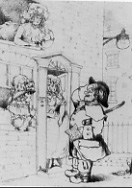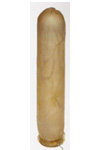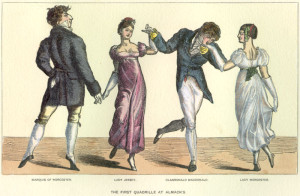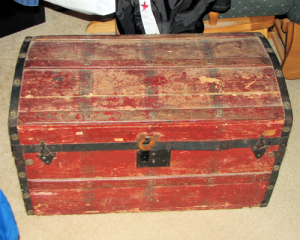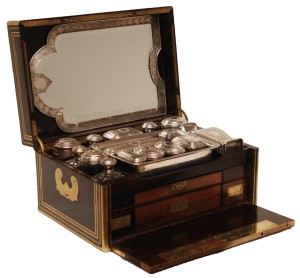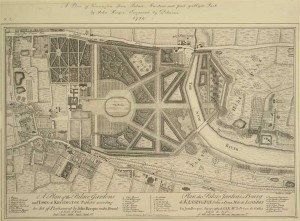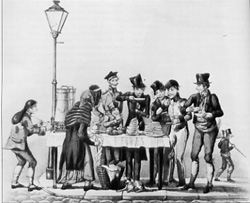A friend just returned from a holiday in England and, knowing what kind of girl I am (a writer), she brought me The Georgian Bawdyhouse by Emily Brand. This is one of the excellent Shire Library books found in many of the UK National Trust gift shops. I’m not sure where Laurel got this one. I’ll have to ask her.
Since we’re all interested in bawdyhouses, I thought I’d share some of it with you. The book addresses the long 18th century, but does concentrate largely on the 17th and early 18th. In fact, the illustration at the top of the table of contents is of a Regency era Prince of Wales disporting himself at a bordello.
Brand tells us that bawdyhouses were not under the exclusive direction of women. Men (called panders) ran some of the houses and, in some cases, a husband and wife team were in charge. Regardless of who was running it, a brothel could be highly lucrative. In 1743, the Gentleman’s Magazine speculated that Mother Hayward (owner of a bawdyhouse), was worth £10,000 at her death.
Bawdyhouses ran the gamut from poverty-stricken garrets to elegant (or at least expensive) townhouses. Indeed, The Folly was a floating brothel on the Thames.
Prostitution was not illegal, but bawdyhouses could be punished for disturbing the peace. So, apparently, maintaining a respectable appearance was an important factor in running a successful house of ill repute.
Brand gives us a selection of terms for prostitutes: drazil-drozzle from Hampshire, dolly-tripe in Warwickshire. The lowest of these were the bunters and hedge-whores. The loftier were squirrels and demi-reps. Their average age was 16 to 24. Between 1757 and 1795, Harris’s List of Covent Garden Ladies, rather a prostitute directory, provided descriptions of working women, including their age.
The Georgian Bawdyhouse also includes a chapter on the men who frequented these establishment. These ranged from sailors and visiting country squires to The Dukes of Wellington and Queensberry. Of course, the types of houses these men would attend would vary widely, from the tawdry to the palatial.
Although most of these men gave no thought to impregnating their partners, disease was not uncommon and various types of “cures” (taking the waters, mercury, a remedy served in hot chocolate) and preventive measures existed. Early condoms were made of linen, silk or leather. By the early 19th century, sheep gut soaked in water and tied with a ribbon was the usual. Other inventive measures were taken. Apparently, Casanova once persuaded a lover to use half a lemon rind as a cervical cap.
There is a lot of information in this small book and it’s full of illustrations. Gillray is amply represented. It’s well worth a look if you’re interested in the seamier side of life in the Georgian city. Thanks for the souvenier, Laurel.


